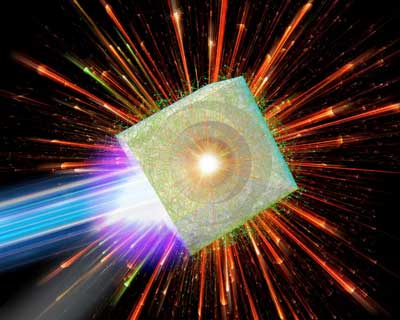| Posted: May 24, 2018 |
Could a particle accelerator using laser-driven implosion become a reality?
(Nanowerk News) Laser pulse compression technology invented in the late 1980s developed high-power short-pulse laser techniques, enhancing laser intensity 10-million-fold in a quarter of a century.
|
|
Scientists at Osaka University discovered a novel particle acceleration mechanism called 'Micro-bubble implosion,' in which super-high energy hydrogen ions (relativistic protons) are emitted at the moment when bubbles shrink to atomic size through the irradiation of hydrides with micron-sized spherical bubbles by ultraintense laser pulses.
|
|
Their research results were published in Scientific Reports ("Generation of ultrahigh field by micro-bubble implosion").
|
 |
| This is a schematic view of a bubble implosion, which is an envisioned picture showing the whole main events integrated, i.e., laser illumination, hot electron spread, implosion, and proton flash. (Image: M. Murakami)
|
|
The group led by Masakatsu Murakami has reported an astonishing physical phenomenon: when shrinking matter to the unprecedented high level, with density comparable to matter the size of a sugar cube weighing more than 100 kg, high-energy protons are emitted from the positively-charged nanoscale clusters, a world first. Usually, an acceleration distance of several tens to hundreds of meters is necessary for conventional accelerators to generate such huge energy.
|
|
In micro-bubble implosion, a unique ion motion in which ions (charged particles) converge to a single point in space at half the speed of light plays a crucial role. This phenomenon, which looks like the opposite of the Big Bang, is essentially different from any previously discovered or proposed acceleration principles.
|
|
This new concept will clarify unknown space physics of grand scales of time and space, such as the origins of high-energy protons moving about in stars and space. In addition, as a compact source of neutron radiation through nuclear fusion, this concept will be utilized in a variety of applications in medical treatment and industry in the future, such as proton radiotherapy to treat cancer, the development of new energy with laser nuclear fusion, cross-sectional photos for developing fuel cells, and development of new substances.
|

